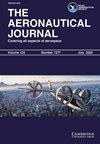Cowl Shapes of Minimum Drag in Supersonic Flow
IF 1.6
4区 工程技术
Q2 ENGINEERING, AEROSPACE
引用次数: 3
Abstract
Guderley, Armitage and Valentine have computed the inlet and closed body contours which form the forepart of an axially symmetric body, of given length and fineness ratio, having minimum pressure drag. The solution is not based on a simplified pressure law, such as the Newtonian impact law, because by a suitable choice of control surface for mass flow and momentum they are able to employ the general flow equations. It is clear, however, from an analysis of their tabulated results that their cowl shapes fall on a single curve for a given value of Δ=didt, the ratio of the initial to the final diameter of the cowl, when plotted in terms of a dimensionless length ξ=x/l and thickness η=y/dt, as in Fig. 1. Furthermore Fig. 1 shows that, except for small values of Δ, the Guderley shapes are indistinguishable from the optimum shapes calculated from Newtonian impact theory. The shape and characteristics of the Newtonian duct of given length and thickness, offering minimum drag to the external stream, are derived using the slender-body approximation. Ducts for which Δ > 0.04 are shown to be sufficiently slender. The slopes of those with 0 ≤ Δ < 0.04 are too large only in a small critical region near the nose. Thus slender body theory will give a close approximation to the exact Newtonian solution even in these cases. For the larger values of Δ likely to be used in practice slender body theory is valid everywhere.超声速流动中最小阻力的冷罩形状
Guderley, Armitage和Valentine计算了在给定长度和细度比下具有最小压力阻力的轴对称体前部的入口和封闭体轮廓。该解决方案不是基于简化的压力定律,如牛顿冲击定律,因为通过选择合适的质量流量和动量控制面,他们能够采用一般的流动方程。然而,从他们的表格结果的分析中可以清楚地看到,对于给定值Δ=didt,当以无因次长度ξ=x/l和厚度η=y/dt绘制时,他们的罩形落在一条曲线上,如图1所示。此外,从图1中可以看出,除了Δ的小值外,Guderley形状与牛顿碰撞理论计算的最佳形状难以区分。给定长度和厚度的牛顿管道的形状和特性,为外部流提供最小的阻力,使用细长体近似导出。导管Δ > 0.04显示为足够细长。0≤Δ < 0.04仅在鼻部附近的小临界区域斜率过大。因此,即使在这些情况下,细长体理论也会给出一个近似于牛顿解的精确解。对于实际中可能使用的较大的Δ值,细长体理论在任何地方都是有效的。
本文章由计算机程序翻译,如有差异,请以英文原文为准。
求助全文
约1分钟内获得全文
求助全文
来源期刊

Aeronautical Journal
工程技术-工程:宇航
CiteScore
3.70
自引率
14.30%
发文量
86
审稿时长
6-12 weeks
期刊介绍:
The Aeronautical Journal contains original papers on all aspects of research, design and development, construction and operation of aircraft and space vehicles. Papers are therefore solicited on all aspects of research, design and development, construction and operation of aircraft and space vehicles. Papers are also welcomed which review, comprehensively, the results of recent research developments in any of the above topics.
 求助内容:
求助内容: 应助结果提醒方式:
应助结果提醒方式:


